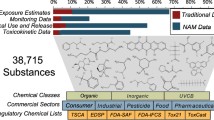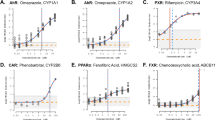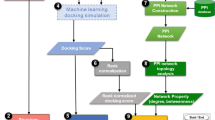Abstract
Addressing the safety aspects of drugs and environmental chemicals has historically been undertaken through animal testing. However, the quantity of chemicals in need of assessment and the challenges of species extrapolation require the development of alternative approaches. Our approach, the US Environmental Protection Agency's ToxCast program, utilizes a large suite of in vitro and model organism assays to interrogate important chemical libraries and computationally analyze bioactivity profiles. Here we evaluated one component of the ToxCast program, the use of primary human cell systems, by screening for chemicals that disrupt physiologically important pathways. Chemical-response signatures for 87 endpoints covering molecular functions relevant to toxic and therapeutic pathways were generated in eight cell systems for 641 environmental chemicals and 135 reference pharmaceuticals and failed drugs. Computational clustering of the profiling data provided insights into the polypharmacology and potential off-target effects for many chemicals that have limited or no toxicity information. The endpoints measured can be closely linked to in vivo outcomes, such as the upregulation of tissue factor in endothelial cell systems by compounds linked to the risk of thrombosis in vivo. Our results demonstrate that assaying complex biological pathways in primary human cells can identify potential chemical targets, toxicological liabilities and mechanisms useful for elucidating adverse outcome pathways.
This is a preview of subscription content, access via your institution
Access options
Subscribe to this journal
Receive 12 print issues and online access
$209.00 per year
only $17.42 per issue
Buy this article
- Purchase on Springer Link
- Instant access to full article PDF
Prices may be subject to local taxes which are calculated during checkout




Similar content being viewed by others
References
Arrowsmith, J. Trial watch, phase III and submission failures, 2007–2010. Nat. Rev. Drug Discov. 10, 87 (2011).
Judson, R. et al. The toxicity data landscape for environmental chemicals. Environ. Health Perspect. 117, 685–695 (2009).
National Research Council. Toxicity Testing in the 21st Century: a Vision and a Strategy (National Academies Press, Washington DC, 2007).
Bowes, J. et al. Reducing safety-related drug attrition: the use of in vitro pharmacological profiling. Nat. Rev. Drug Discov. 11, 909–922 (2012).
Houck, K.A. & Kavlock, R.J. Understanding mechanisms of toxicity: insights from drug discovery research. Toxicol. Appl. Pharmacol. 227, 163–178 (2008).
Chen, Y. & Shoichet, B.K. Molecular docking and ligand specificity in fragment-based inhibitor discovery. Nat. Chem. Biol. 5, 358–364 (2009).
Kitchen, D.B., Decornez, H., Furr, J.R. & Bajorath, J. Docking and scoring in virtual screening for drug discovery: methods and applications. Nat. Rev. Drug Discov. 3, 935–949 (2004).
Lounkine, E. et al. Large-scale prediction and testing of drug activity on side-effect targets. Nature 486, 361–367 (2012).
Berg, E., Yang, J. & Polokoff, M. Building predictive models for mechanism of action classification from phenotypic assay datasets. J. Biomol. Screen. 18, 1260–1269 (2013).
Berg, E.L., Kunkel, E.J., Hytopoulos, E. & Plavec, I. Characterization of compound mechanisms and secondary activities by BioMAP analysis. J. Pharmacol. Toxicol. Methods 53, 67–74 (2006).
Berg, E.L. et al. Chemical target and pathway toxicity mechanisms defined in primary human cell systems. J. Pharmacol. Toxicol. Methods 61, 3–15 (2010).
Houck, K.A. et al. Profiling bioactivity of the ToxCast chemical library using BioMAP primary human cell systems. J. Biomol. Screen. 14, 1054–1066 (2009).
Kleinstreuer, N.C. et al. Environmental impact on vascular development predicted by high-throughput screening. Environ. Health Perspect. 119, 1596–1603 (2011).
Martin, M.T. et al. Predictive model of rat reproductive toxicity from ToxCast high throughput screening. Biol. Reprod. 85, 327–339 (2011).
Sipes, N.S. et al. Predictive models of prenatal developmental toxicity from ToxCast high-throughput screening data. Toxicol. Sci. 124, 109–127 (2011).
Dix, D.J. et al. The ToxCast program for prioritizing toxicity testing of environmental chemicals. Toxicol. Sci. 95, 5–12 (2007).
Kavlock, R. et al. Update on EPA's ToxCast program: providing high throughput decision support tools for chemical risk management. Chem. Res. Toxicol. 25, 1287–1302 (2012).
Tice, R.R., Austin, C.P., Kavlock, R.J. & Bucher, J.R. Improving the human hazard characterization of chemicals: a Tox21 update. Environ. Health Perspect. 121, 756–765 (2013).
Ayala, A., Parrado, J., Bougria, M. & Machado, A. Effect of oxidative stress, produced by cumene hydroperoxide, on the various steps of protein synthesis: modifications of elongation factor-2. J. Biol. Chem. 271, 23105–23110 (1996).
Lau, C. et al. Exposure to perfluorooctane sulfonate during pregnancy in rat and mouse. II: postnatal evaluation. Toxicol. Sci. 74, 382–392 (2003).
Bogdanska, J. et al. Tissue distribution of (3)(5)S-labelled perfluorooctane sulfonate in adult mice after oral exposure to a low environmentally relevant dose or a high experimental dose. Toxicology 284, 54–62 (2011).
Arredondo, J. et al. A receptor-mediated mechanism of nicotine toxicity in oral keratinocytes. Lab. Invest. 81, 1653–1668 (2001).
Kleinstreuer, N. et al. A computational model predicting disruption of blood vessel development. PLoS Comput. Biol. 9, e1002996 (2013).
Khaidakov, M. et al. Statins and angiogenesis: is it about connections? Biochem. Biophys. Res. Commun. 387, 543–547 (2009).
Kohonen, T. Essentials of the self-organizing map. Neural Netw. 37, 52–65 (2013).
McCann, F.E. et al. Apremilast, a novel PDE4 inhibitor, inhibits spontaneous production of tumour necrosis factor-alpha from human rheumatoid synovial cells and ameliorates experimental arthritis. Arthritis Res. Ther. 12, R107 (2010).
Viguerie, N. et al. Multiple effects of a short-term dexamethasone treatment in human skeletal muscle and adipose tissue. Physiol. Genomics 44, 141–151 (2012).
Augustine-Rauch, K.A. et al. Evidence for a molecular mechanism of teratogenicity of SB-236057, a 5–HT1B receptor inverse agonist that alters axial formation. Birth Defects Res. A Clin. Mol. Teratol. 70, 789–807 (2004).
Owens, A.P. III & Mackman, N. Role of tissue factor in atherothrombosis. Curr. Atheroscler. Rep. 14, 394–401 (2012).
Camici, G.G. et al. Rapamycin promotes arterial thrombosis in vivo: implications for everolimus and zotarolimus eluting stents. Eur. Heart J. 31, 236–242 (2010).
Barua, R.S. & Ambrose, J.A. Mechanisms of coronary thrombosis in cigarette smoke exposure. Arterioscler. Thromb. Vasc. Biol. 33, 1460–1467 (2013).
Cummings, S.R. et al. The effect of raloxifene on risk of breast cancer in postmenopausal women: results from the MORE randomized trial. Multiple outcomes of raloxifene evaluation. J. Am. Med. Assoc. 281, 2189–2197 (1999).
Lipton, A., Harvey, H.A. & Hamilton, R.W. Venous thrombosis as a side effect of tamoxifen treatment. Cancer Treat. Rep. 68, 887–889 (1984).
Kunkel, E.J. et al. An integrative biology approach for analysis of drug action in models of human vascular inflammation. FASEB J. 18, 1279–1281 (2004).
Plavec, I. et al. Method for analyzing signaling networks in complex cellular systems. Proc. Natl. Acad. Sci. USA 101, 1223–1228 (2004).
Robichaud, A. et al. Assessing the emetic potential of PDE4 inhibitors in rats. Br. J. Pharmacol. 135, 113–118 (2002).
Kirkiacharian, S., Chidiack, H., Philibert, D., Van De Velde, P. & Bouchoux, F. Binding affinity to steroid hormone receptors and antiproliferative action on MCF-7 cells of coumarin derivatives and isoflavonoids. Ann. Pharm. Fr. 57, 332–339 (1999).
Barna, T.M. et al. Crystal structure of pentaerythritol tetranitrate reductase: “flipped” binding geometries for steroid substrates in different redox states of the enzyme. J. Mol. Biol. 310, 433–447 (2001).
Murotani, T., Ishizuka, T., Isogawa, Y., Karashima, M. & Yamatodani, A. Possible involvement of serotonin 5–HT2 receptor in the regulation of feeding behavior through the histaminergic system. Neuropharmacology 61, 228–233 (2011).
Ouattara, B. et al. Changes of AMPA receptors in MPTP monkeys with levodopa-induced dyskinesias. Neuroscience 167, 1160–1167 (2010).
Fell, M.J. et al. Activation of metabotropic glutamate (mGlu)2 receptors suppresses histamine release in limbic brain regions following acute ketamine challenge. Neuropharmacology 58, 632–639 (2010).
Aizu-Yokota, E., Ichinoseki, K. & Sato, Y. Microtubule disruption induced by estradiol in estrogen receptor-positive and -negative human breast cancer cell lines. Carcinogenesis 15, 1875–1879 (1994).
Thiede, A., Gellerich, F.N., Schonfeld, P. & Siemen, D. Complex effects of 17beta-estradiol on mitochondrial function. Biochim. Biophys. Acta 1817, 1747–1753 (2012).
Cohen, S.B. et al. Evaluation of the efficacy and safety of pamapimod, a p38 MAP kinase inhibitor, in a double-blind, methotrexate-controlled study of patients with active rheumatoid arthritis. Arthritis Rheum. 60, 335–344 (2009).
Ding, C. Drug evaluation: VX-702, a MAP kinase inhibitor for rheumatoid arthritis and acute coronary syndrome. Curr. Opin. Investig. Drugs 7, 1020–1025 (2006).
Attene-Ramos, M.S. et al. The Tox21 robotic platform for the assessment of environmental chemicals - from vision to reality. Drug Discov. Today 18, 716–723 (2013).
US Environmental Protection Agency. US Environmental Protection Agency Endocrine Disruptor Screening Program Comprehensive Management Plan. http://www.epa.gov/endo/pubs/edsp21_work_plan_summary%20_overview_final.pdfhttp://www.epa.gov/scipoly/oscpendo/pubs/EDSP_Comprehesive_Management%20Plan_%20021414_f.pdf (Jointly developed by the Office of Chemical Safety & Pollution Prevention and the Office of Water, EPA, 2014).
Kunkel, E.J. et al. Rapid structure-activity and selectivity analysis of kinase inhibitors by BioMAP analysis in complex human primary cell-based models. Assay Drug Dev. Technol. 2, 431–442 (2004).
Williams, O. et al. Discovery of dual inhibitors of the immune cell PI3Ks p110delta and p110gamma: a prototype for new anti-inflammatory drugs. Chem. Biol. 17, 123–134 (2010).
Berg, E.L., Kunkel, E.J. & Hytopoulos, E. Biological complexity and drug discovery: a practical systems biology approach. Syst. Biol. (Stevenage) 152, 201–206 (2005).
Melrose, J., Tsurushita, N., Liu, G. & Berg, E.L. IFN-gamma inhibits activation-induced expression of E- and P-selectin on endothelial cells. J. Immunol. 161, 2457–2464 (1998).
Clark, R.D., Patterson, D.E., Soltanshahi, F., Blake, J.F. & Matthew, J.B. Visualizing substructural fingerprints. J. Mol. Graphics Model. 18, 404–411 (2000).
Acknowledgements
We thank our pharmaceutical industry partners Pfizer, GlaxoSmithKline, Roche, Merck, Sanofi and Astellas for donating 135 failed drugs and providing feedback on the manuscript, and W. Casey, L. Urban, C. Wood and K. Crofton for helpful suggestions on the manuscript. The EPA, through its Office of Research and Development, funded and managed the research described here. The views expressed in this paper are those of the authors and do not necessarily reflect the views or policies of the US Environmental Protection Agency.
Author information
Authors and Affiliations
Contributions
R.J.K., D.J.D. and K.A.H. conceived and supervised the ToxCast project. A.M.R. oversaw chemical management. D.M.R., M.T.M. and R.S.J. designed and operated the data analysis workflow. N.C.K. and K.A.H. wrote the manuscript with editing by T.B.K., R.J.K., J.Y. and E.L.B. J.Y., M.P. and E.L.B. performed the experimental work. N.C.K., J.Y., K.A.H. and E.L.B. carried out the data analysis specific to this manuscript.
Corresponding author
Ethics declarations
Competing interests
J.Y., M.P. and E.L.B. are employees of BioSeek, a Division of DiscoveRx, Inc. and performed the bioassays and assisted with analysis of the results.
Supplementary information
Supplementary Text and Figures
Supplementary Figures 1–4, Supplementary Discussion (PDF 13591 kb)
Supplementary Tables
Supplementary Tables 1–13 (XLSX 10025 kb)
Rights and permissions
About this article
Cite this article
Kleinstreuer, N., Yang, J., Berg, E. et al. Phenotypic screening of the ToxCast chemical library to classify toxic and therapeutic mechanisms. Nat Biotechnol 32, 583–591 (2014). https://doi.org/10.1038/nbt.2914
Received:
Accepted:
Published:
Issue Date:
DOI: https://doi.org/10.1038/nbt.2914
This article is cited by
-
Ras-mutant cancers are sensitive to small molecule inhibition of V-type ATPases in mice
Nature Biotechnology (2022)
-
Investigating the antifibrotic effect of the antiparasitic drug Praziquantel in in vitro and in vivo preclinical models
Scientific Reports (2020)
-
High-Throughput Screening to Predict Chemical-Assay Interference
Scientific Reports (2020)
-
Optimum concentration–response curve metrics for supervised selection of discriminative cellular phenotypic endpoints for chemical hazard assessment
Archives of Toxicology (2020)
-
From discoveries in ageing research to therapeutics for healthy ageing
Nature (2019)



